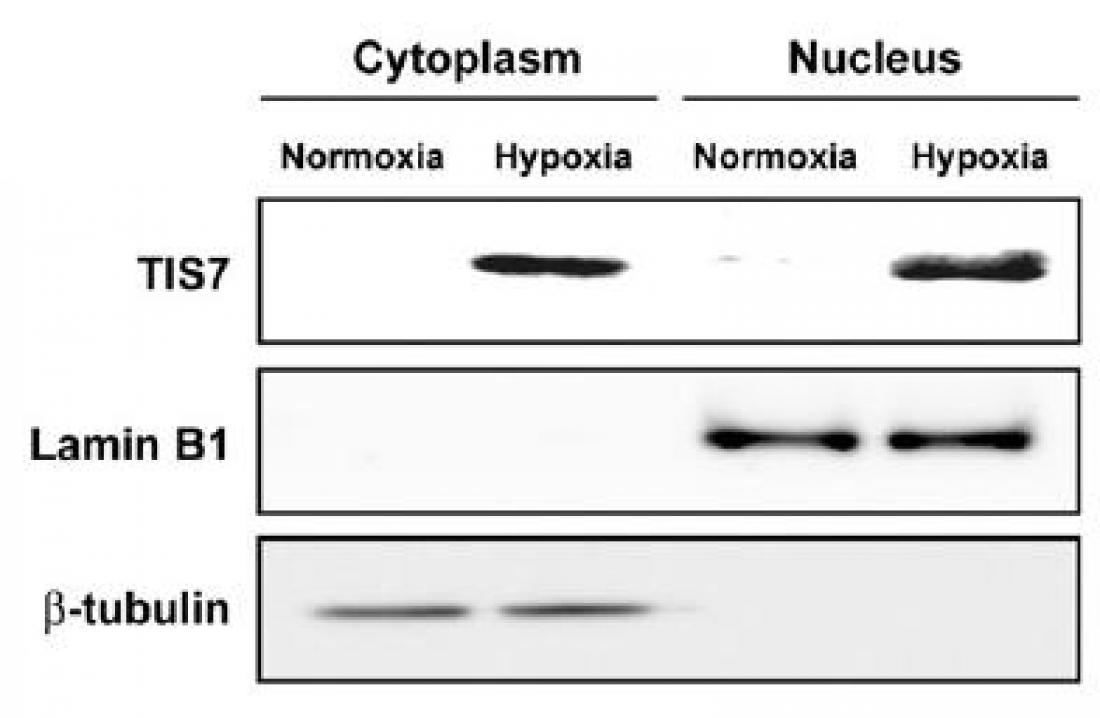3T3-L1 cells cultured under normoxia and hypoxia, followed by fractionation of both nucleus and cytoplasm: TIS7, Lamin B1 and β-tubulin expression determined by immunoblotting.
This research is also described in the inaugural June issue of the Kanazawa University Research Bulletin: http://www.kanazawa-u.ac.jp/research_bulletin/index.html
Studies of the effects of oxygen deprivation in the body fat of obese animals have revealed links with the regulation of fat cell generation. Researchers at Kanazawa University have identified the role of the protein TIS7 in processes that regulate adipogenesis, whereby non-specialised cells become adipose or fat cells. They add, “TIS7 could be a target for the discovery and development of a drug useful for the treatment and therapy of obesity or a variety of obesity-related metabolic diseases including type-2 diabetes and atherosclerosis.”
Adipose tissue is essential for whole body homeostasis, storing excess energy and potentially a number of other physiological processes. Deregulation of these functions is found in obesity, prompting further study of the mechanisms behind white adipose tissue development.
Adipose tissue is poorly oxygenated in obese humans and animals. Poor oxygenation or ‘hypoxia’ has been linked to a number of diseases including heart and lung disorders, anemia, and circulation problems. There have also been reports indicating that the protein TIS7 is expressed in tissues following injuries, such as ischemia, stroke or muscle trauma. Yukio Yoneda and colleagues at the University of Kanazawa monitored TIS7 expression in vitro and found that it was drastically increased by hypoxic stress.
The researchers then compared mice fed different diets and found significant up-regulation of TIS7 in the white adipose tissue of mice fed a high fat diet. Following further studies of various aspects of adipogenesis and the role of hypoxia and TIS7, the researchers conclude, “It thus appears that TIS7 is a novel pivotal transcriptional regulator of hypoxia-induced repression of adipogenesis.” They add that further studies are needed to understand the exact mechanism underlying the up-regulation of TIS7 under hypoxia in cells prior to adipogenesis.
Further information
Organization of Frontier Science and Innovation, Kanazawa University
Kakuma, Kanazawa, Ishikawa 920-1192, Japan
E-mail: [email protected]
Website: http://www.o-fsi.kanazawa-u.ac.jp/en/about/
About Kanazawa University
As the leading comprehensive university on the Sea of Japan coast, Kanazawa University has contributed greatly to higher education and academic research in Japan since it was founded in 1949. The University has three colleges and 16 schools offering courses in subjects that include medicine, computer engineering, and humanities.
The University is located on the coast of the Sea of Japan in Kanazawa—a city rich in history and culture. The city of Kanazawa has cultivated a highly respected intellectual profile since the time of the Kaga fiefdom (1598–1867). Kanazawa University is divided into two main campuses: Kakuma and Takaramachi for its approximately 12,200 students including 500 from overseas.
Kanazawa University website: http://www.kanazawa-u.ac.jp/e/index.html



